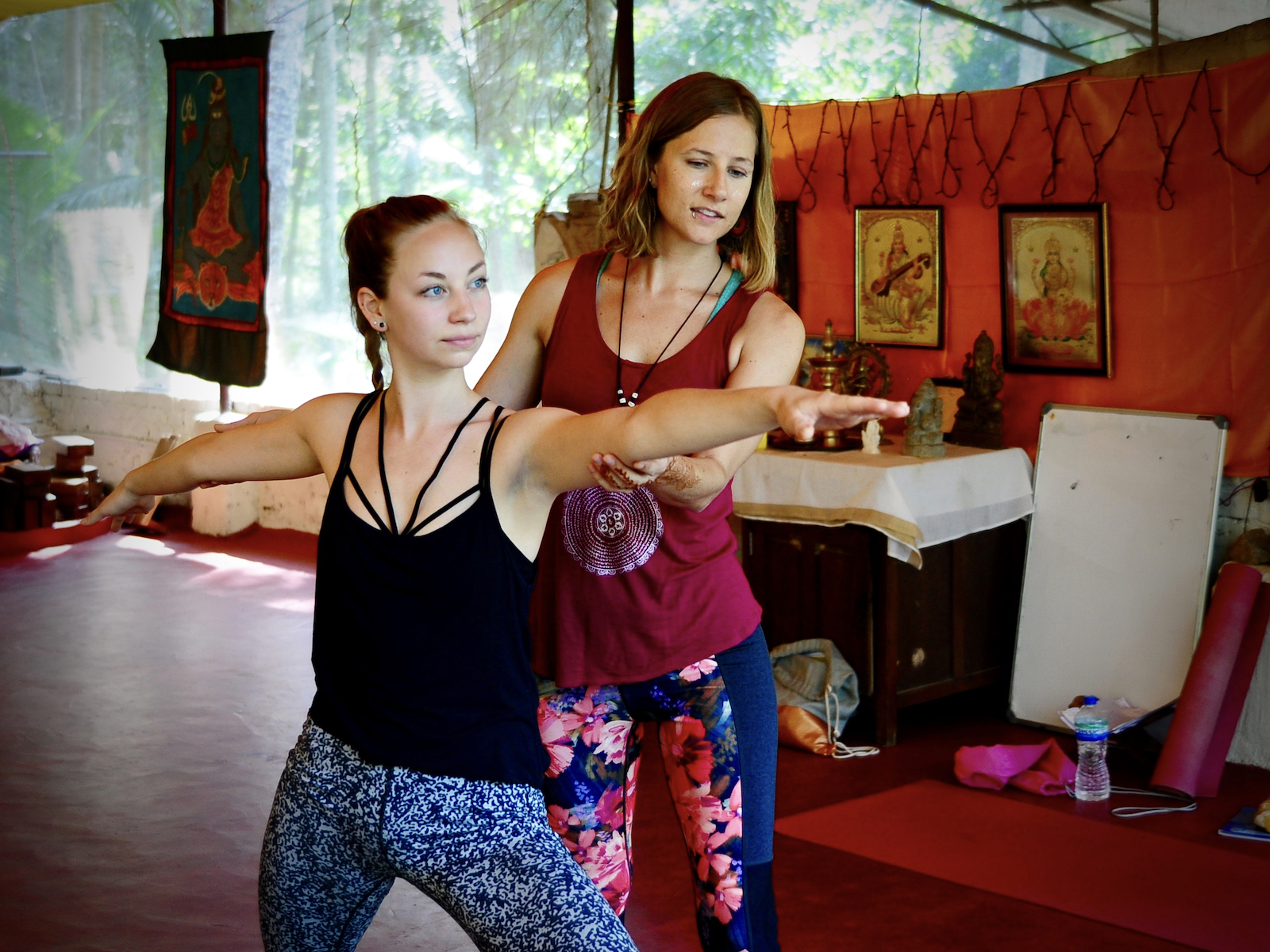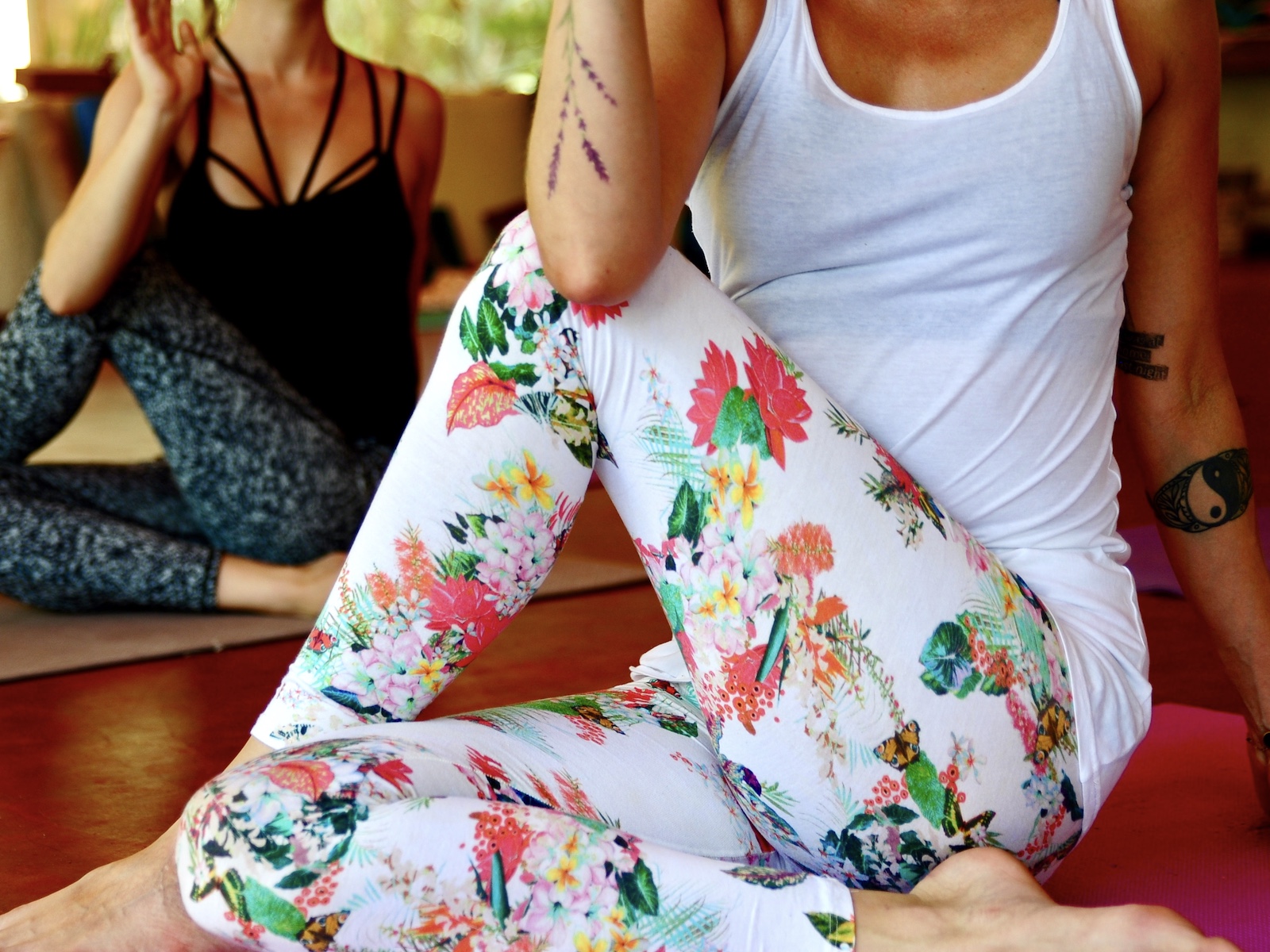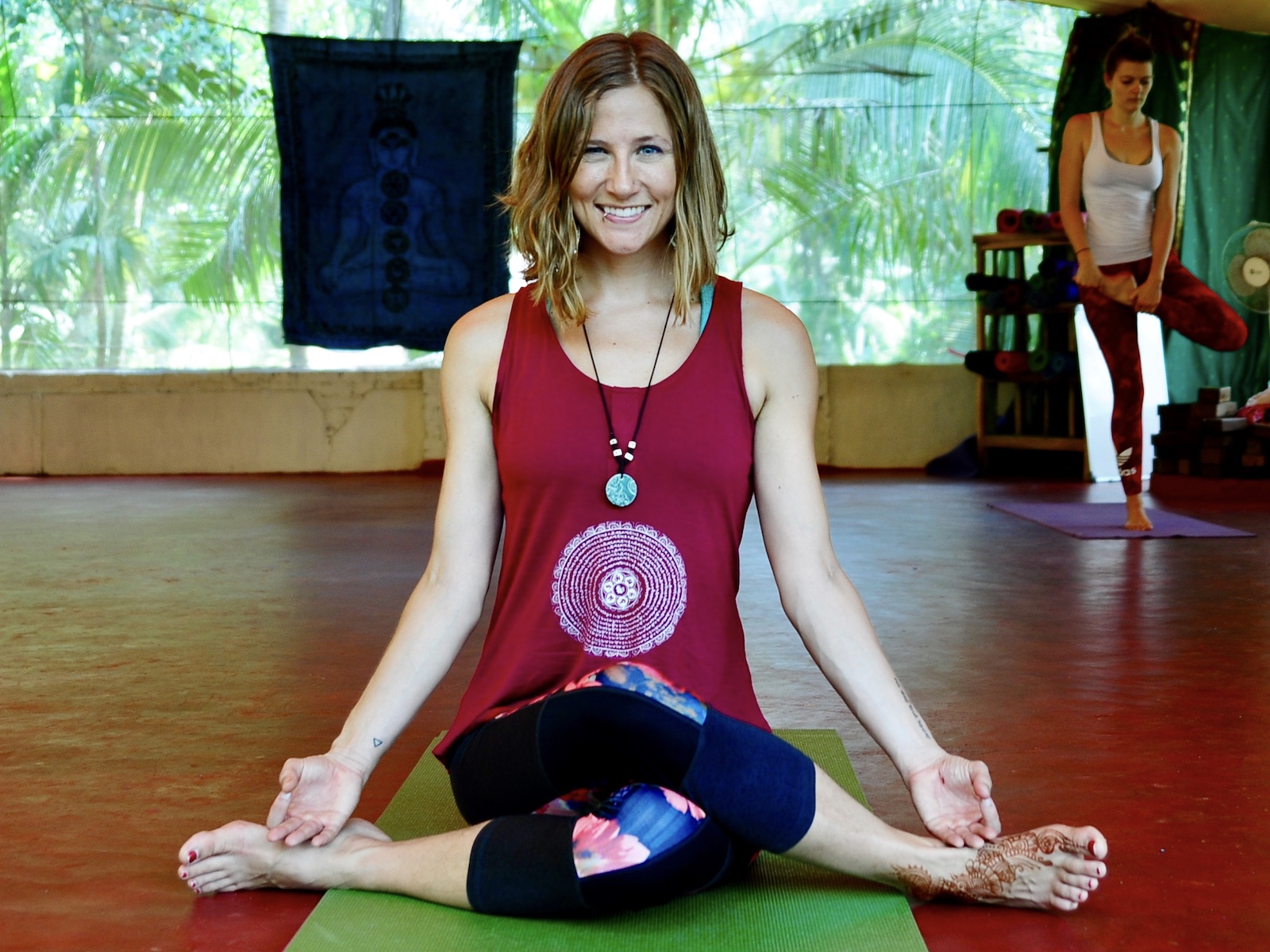
I strained to hear my teacher over the construction noises next door and the birds calling out to each other as she explained the story behind the Bhagavad Gita to our group of 28 aspiring yogis. It was three in the afternoon and we still had another hour of lecture and two more hours of yoga to go before our usual evening routine of dinner, studying and a nice early bedtime. I squirmed to find a comfortable position on my wooden block, scarves tucked under my knees, then finally gave up and lay down flat on my mat, chin propped up on both my hands as I fought the afternoon snooze brought on by the relentless heat and humidity.
This was how my days were spent during the month of January as I made my way through my very first 200-hour yoga teacher training in Kerala, a state along the southwest coast of India. Despite the sweaty days and long hours spent on our mats, it was anything but boring and months later, I am still teasing apart all the lessons that came from this intense immersion into everything yoga. Although I had expected both physical and mental growth, I did not understand just how much it would seep into every other aspect of my life while setting me on a path of exploration to understand my place in yoga and its place in our Western culture.
I had long dreamed of becoming a yoga teacher, having started practicing 10 years prior, but somehow it always seemed just out of reach, an ethereal profession reserved only for the special few and not for me. It also seemed way too good to be true that anyone could actually get paid for leading yoga classes, despite the seemingly endless new studios popping up around my city every day.
It wasn’t until my friend Tayler told me about her plans to attend Padma Karma that I finally decided to take the plunge. She and I were planning separate trips to Southeast Asia, both with a flexible itinerary, and when I found out she was going to become a yoga teacher, it seemed as good a time as any to make it happen at last. I put surprisingly little effort into researching the school we ended up choosing; Tayler had narrowed it down to two options and both looked like official yoga schools to me.
In other words, I wasn’t picky, but I trusted my friend and was open to whatever was in store. If I’d been more discerning in my choices, I might have looked for a school with a stronger focus on anatomy and physiology, but what I got was a training deeply rooted in Yogic philosophies wrapped up in a completely authentic Indian experience. Disappointed at first by the lack of anatomical detail, I later realized that you can learn about the body anywhere, but the best way to fully understand the heart of yoga is through firsthand experiences with locals in the country of its birth.
We learned about sutras and vedas, memorized chants in Sanskrit, studied the chakras and energy lines in the body and delved deep into the stories behind many of the Hindu Gods. We practiced our pranayama and physical asanas for four hours each day and by week two we were leading our peers through set hatha sequences. Though at first most of us struggled to simply remember the moves, by week three we were cultivating our individual teaching styles and creating our own classes.
Because our training took place in January at the start of the new year, we had the opportunity to attend nightly showcases of dancing, soccer, martial arts, Katakhali and more, as part of the month-long festival taking place on the beach. We visited a local temple on a nearby hill where we stumbled through long-held Indian rituals to honor the Gods, each of us glancing furtively at the others to see if we were doing it right. And once during our training, a group of 10 Indian percussionists came to our shala and played energetic live beats just for us, their drumming and voices in perfect union with one another.
These experiences immersed me in Indian culture and the yogic lifestyle in a way that I would not have been exposed to had I done my training at home.

While yoga is about much more than just the physical practice, the asanas are of course an integral component and the aspect Westerners are most familiar with. In that one month of training, despite an unfortunate rotator cuff injury that slowed me down after the first week of rigorous classes, my physical abilities improved to a level I never would have imagined in such a short amount of time.
Most of our teachers were Indian men who seemed not to have gotten the memo that yoga teachers are supposed to be calming, encouraging and gentle. The teacher we called Freddy Mercury, on account of his substantial and impressive moustache, adjusted every single person in every single pose, calmly reminding you to breathe as you struggled to maintain your inner peace. He quickly became both our most loved and most dreaded instructor, often pushing us to contort our bodies into such uncomfortable positions I was certain something was about to break.
Ginu, another instructor, was small but mighty and I quickly learned to crave his approval. I carefully tracked the amount of attention I received compared to other students in each class and it was a constant battle for my ego not to feel hurt when I found myself lacking. The less he paid attention to me, the harder I worked to contort myself into poses I wasn’t sure I should be attempting. Though in class he could seem uncaring and unsympathetic, as time went on I discovered that his harshness came from a desire to see us improve.
Throughout the training, I developed a sense that each of our teachers had a much clearer idea of what we were capable of than we did ourselves. As such, I improved at a much greater speed in that one month than I had in the past ten years of practice. I became determined that I would be the kind of teacher who was willing to push her students to reach their full potential, which I felt was lacking in many of the teachers I had seen in the States.
Early on, a group of us who seemed determined to become experts or die trying were soon labeled “The Extremists” by Padma, the woman who ran the school and taught most of our lectures. Though a big part of me swelled in pride with this designation, I also felt the pressure of living up to the name which only added to my already intense desire to prove myself. To whom I was attempting to prove myself, I’m still not entirely sure; the teachers, the other students, myself? Most likely a combination of all three.
Every yoga class soon became a lesson in checking my ego and searching for what my own personal motivations truly were. Injuring my shoulder turned out to be a great lesson in listening to my own body and disregarding my desire to be perceived as “hardcore.” As I learned to make modifications for myself so that my shoulder wouldn’t get worse, I also had to learn to let go of the fear that others would perceive me as weak or think I was slacking off. My yoga practice was for me and me alone and pushing my body through an injury was completely counter to the goal of physical and mental wellness.
I still find myself fighting the urge to appear “good at yoga” every time I step on the mat, perhaps even more so now that I am a teacher and my skills have improved beyond that of many of my usual classmates. It is a constant practice in pushing aside the ego, listening to my body, and not worrying about how I am perceived by others.
On the flip side, I also have to remind myself that it is okay to try harder moves, that it doesn’t mean I am “showing off” just because I want to improve or work on something challenging in a class. One of the greatest lessons I have learned from yoga is to meet myself where I am at and to do so independently of what is going on around me or in the minds of others. This is a lesson that applies not only in yoga but in pretty much everything I do and for that I am incredibly grateful. It is also a lesson I do my best to pass along to my students, including the fact that yoga encompasses much more than just suave-looking postures that look good on social media.

Unfortunately, while the roots of yoga are aimed at achieving a healthy mind, body, and soul, Western adoption of the practice has created an entire industry based largely on appearances. Many studios promote yoga as a means to sculpt the perfect beach body or shed pounds and I have even heard of classes that operate more like a boot camp and push students to work through the pain and deny themselves water when they are thirsty. That may be one way to exercise, but it certainly isn’t yoga.
Yoga is intended to be accessible for anyone who wishes to increase their strength and flexibility and cultivate a greater mindfulness in their life, not simply those who can afford expensive spandex, mats made from recycled materials and monthly studio memberships (though I am certainly guilty of purchasing all of those things). It is for the young and the old, the thin and the overweight, the male and the female and everyone in between.
The word yoga comes from the root yuj which means “union”: union of breath and movement, union of the mind, spirit and body, union of the individual with the universal. It is so much more than the physical movements we practice and in fact, asana is just one of the eight limbs of yoga, a means of getting our physical body to a point where we can comfortably sit for long periods of time and meditate. The ultimate goal of yoga has nothing to do with impressing others by twisting into a pretzel for your Instagram account and everything to do with attaining deeper states of meditative awareness and overall contentment.
Yoga is a lifestyle, a philosophy, a way of living that has centuries-old Indian roots and has been alternately oppressed, idolized, borrowed and bastardized by Westerners looking to either demonize or profit from its seemingly mystical powers. Today yoga is as widespread in America as apples in a grocery store and in a similar way, many of us consume it without having any connection to or awareness of its origins.

I entered into this month-long training with the goal of becoming a yoga teacher, but what I didn’t expect was to work through so much personal shit in the process and come away with many more questions about both yoga and myself, many of which I am still discovering and working through. Tears were a daily occurrence for me, their cause constantly shifting: mental and physical fatigue, fear of not succeeding, news of a death back home, digging up of past wounds, lack of air conditioning, homesickness, spicy food.
Luckily, there is no better place to ride an emotional rollercoaster than in a room full of empathetic yogis who are currently on the same crazy ride, or at least attending the same carnival. One morning you’re being sweetly held by three classmates as you collapse into a flood of tears after morning practice and that evening you’re bringing coconut water to a friend who spent the day throwing up from heat exhaustion.
Knowing that I was surrounded by these loving, supportive individuals made it possible to push through all the challenges and show up in an authentic way each day. This was the community that Padma and her fellow teachers created for us and I could not have made it through that month without such a special group of humans by my side.
I’ve been back in Portland teaching yoga for almost six months now and I absolutely love it. There is something truly special about being paid to guide people through a practice that has such huge potential to be physically and mentally healing. That being said, I don’t have any illusions about yoga being infallible. I discovered first-hand during my teacher training that injuries in yoga are commonplace, especially when you push yourself too hard too fast.
Anyone who has completed a 200-hour yoga teacher training would probably agree that it’s less of a comprehensive guide to teaching and more of an introduction to all the topics and movements you now have to spend the rest of your life exploring and improving upon to remain an excellent teacher. You can only cram so much information into one month and the teachers I know who are truly effective have been immersing themselves in yoga for years.
In addition, yoga’s history in the West is complicated and as I continue to deepen my knowledge of this ancient tradition, I am learning to question my own connection with yoga and, as a white American, my ability to share it without disregarding the culture from which it comes. The more I learn, the more I struggle to understand the role I can play in the lives of others as a yoga teacher and the role that all of this plays in mine. I know I want to be a good world citizen, that I want my students to benefit from yoga in the same ways that I have, and that I want to be respectful to the culture from which I have gained so much.
Is it wrong for me to teach yoga if I’m not Indian? How can I bring aspects of Indian culture into my practice without sharing things that aren’t mine to share? How can I educate others about yoga’s history without coming across as preachy and holier-than-thou? Is it my place to teach the other aspects of yoga to students who came to my class just to get a workout?
These are questions I wrestle with on a daily basis now and I encourage other Western teachers to do the same. It would be easier to ignore these moral dilemmas, provide our students with a good class and call it a day, but if we are going to benefit from yoga then we owe it to the people from whom we have borrowed it to educate ourselves and honor their culture.
At the end of the day, I know that I have only scratched the surface of the crazy journey yoga has to offer. I am forever grateful for the role it has played in my past, the places and the people it has connected me with and I am curious to see where it will take me in the future. But of course, as yoga teaches us, the only thing that truly exists is the present moment, so for now I will continue to read, explore, practice, meditate and above all else, breathe.

/
![]() Olive Ryan is a traveler, educator, blogger, photographer, lover of glitter and acroyoga enthusiast. Although her hometown is Portland, Oregon, she has lived in and explored many corners of the world and looks forward to spending the rest of her life doing so. Find more of her writing on her travel and wellness blog, OliveAbroad.com.
Olive Ryan is a traveler, educator, blogger, photographer, lover of glitter and acroyoga enthusiast. Although her hometown is Portland, Oregon, she has lived in and explored many corners of the world and looks forward to spending the rest of her life doing so. Find more of her writing on her travel and wellness blog, OliveAbroad.com.
The post From Student to Teacher: My Yoga Journey in Kerala appeared first on The Expeditioner Travel Site.
from The Expeditioner Travel Site http://bit.ly/2F9L53s
No comments:
Post a Comment